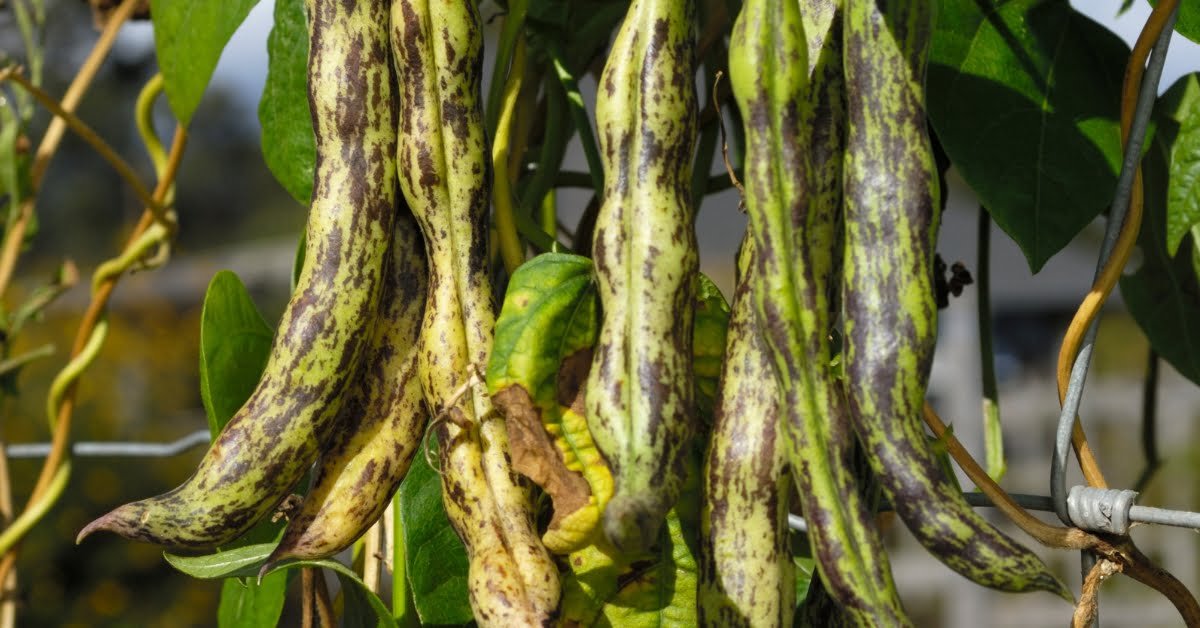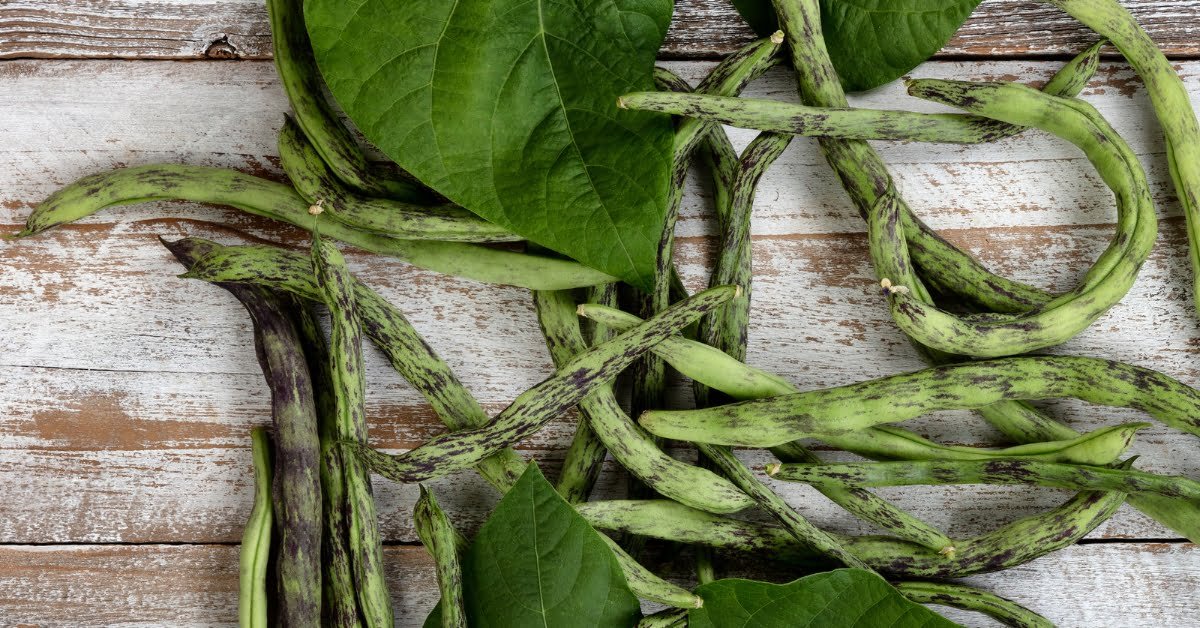The pretty patterned pods of Rattlesnake pole beans make delicious fresh snap beans. Or let the seeds mature and dry in the pods, then shell them for nutty-tasting and nutritious dried bean dishes. Distinctive purple pole beans are renowned for flavor and reliability, offering long, tender, crunchy pods whose rich color stands out from the vines so they are fun and easy to harvest. Both of these treasured heirloom beans have been passed down among generations of gardeners.
Rattlesnake Pole Bean
| Common Names or AKA Names: |
|
| Botanical Name: | Phaseolus vulgaris |
| Family: | Fabaceae |
| Plant Type (Zone 8b): | Annual |
| Hardiness Zones: | Zones 3 through 11 |
| Mature Size: | 72″ – 120+” inches tall, 12″ – 18″ inches wide |
| Native Area: | Southeastern United States |
| Bloom/Harvest Time: | 62-65 Days to Harvest (Spring/Summer) |
| Sun/Light Exposure: | 6 to 12 hours of Light. |
| Planting Depth: | 1” deep |
| Soil Preferences: | Well-Drained Soil |
| Soil pH: | 6.0 – 7.5 pH |
| Aquaponically-Friendly: | YES | LEARN MORE |
| Hydroponically-Friendly: | YES | LEARN MORE |
DESCRIPTION:
Rattlesnake Pole Bean is an heirloom variety of pole bean that has been grown for centuries. The plant grows up to 10 feet tall, with large dark green leaves and clusters of white–green flowers that eventually turn into long pods filled with beans. This type of bean requires a lot of space to grow as it will sprawl along the ground or clamber over structures and other plants in its way. It‘s also very tolerant of drought conditions, making it a great choice for those living in dry climates.
The Rattlesnake Pole Bean produces huge yields when planted properly; they can produce up to 100 pounds per hundred square feet! The beans themselves are tender and flavorful, perfect for soups and stews or just cooked as a side dish. They have a creamy texture when cooked that makes them especially delectable. Additionally, these beans provide essential vitamins such as thiamine (B1), riboflavin (B2), folate (B9) and dietary fiber which all contribute to overall health benefits from consuming this type of legume regularly.
Rattlesnake Pole Beans are a delightful addition to any garden. With their pretty patterned pods, they can be enjoyed fresh as snap beans or the mature seeds can be dried in the pods and then shelled for nutty–tasting, nutritious dishes. Another variety of pole bean – the purple pole bean – is famous for its flavor and reliability. The long, tender pods have a rich color that stands out from other varieties on the vines so harvesting them becomes an enjoyable experience. Both of these heirloom beans have been passed down among generations of gardeners since antiquity due to their unique qualities and flavors!
The Rattlesnake Pole Bean‘s crunchy texture adds an extra level of appeal when served as snap beans or in salads, while its dry form works well in soups and stews with other vegetables. They also make great side dishes by themselves or mixed with rice or pasta for added flavor and nutrition. For those looking to add more color to their meals, this type of bean’s vibrant hue will easily brighten up even boring recipes into something flavorful!
In addition to being delicious, Rattlesnake Poles Beans are easy enough for beginner gardeners so if you‘re looking for something simple yet rewarding then this could be the right vegetable for your home garden! They‘ll need at least 6 hours of sunlight each day so make sure there is plenty available before planting them out in springtime after all chance frost has passed through your area – typically around mid-April depending on location. Finally don’t forget about regular watering throughout their growing season; give them 1-2 inches weekly during hot weather but reduce this amount slightly once temperatures cool down at nightfall since too much water can cause root rot or mildew growths on the foliage itself.
USE:
Rattlesnake Pole Bean is a versatile vegetable that can be used in many different dishes. Its tender and flavorful beans are perfect for soups, stews, side dishes or just cooked by themselves. The leaves of the plant can also be eaten as part of salads or steamed as a green vegetable on their own. Furthermore, this variety of bean provides an excellent source of essential vitamins such as thiamine (B1), riboflavin (B2), folate (B9) and dietary fiber which all contribute to overall health benefits from consuming this type of legume regularly. Additionally, its sprawling vine–like characteristics make it great for use in trellises and other structures where you need something with height but still want it to take up minimal space – plus they‘ll look beautiful when flowering!
Rattlesnake beans are a great option for small gardens and feeding your family. They can be eaten in several different stages of their lifecycle, making them extremely versatile.
Young rattlesnake beans, usually about 3–6 inches long, are tender and sweet. Although they don’t taste good raw like sugar snap peas do, these young beans make an excellent addition to sautés or other cooked dishes. The pods at this stage also tend to be quite hearty when full length. If left on the plant too long however, they will toughen up and develop a removable string along both sides that should be removed before eating them.
When older and more mature, the outer shell of the bean will toughen and not be edible anymore. However you can still cook with rattlesnake beans at this stage by leaving them on the vine until dried out or picking them fresh then freezing or dehydrating for later use. This is known as classic usage for preacher/rattlesnake beans because when cooked correctly they have a meaty texture that stands up well in soups or chili recipes!
Culture & Cultivation:
Rattlesnake Pole Bean is an easy–to–grow heirloom variety that can provide huge yields when planted properly. It requires full sun and well-drained soil, with consistent watering during its growing season – 1-2 inches per week in hot weather but reduce this amount slightly once temperatures cool down at nightfall since too much water can cause root rot or mildew growths on the foliage itself.
This type of bean will happily clamber over structures and other plants to reach higher heights so make sure you have plenty of space available before planting out in springtime after all chance frost has passed through your area – typically around mid-April depending on location. The plant grows up to 10 feet tall and produces large dark green leaves as well as clusters of white-green flowers that eventually turn into long pods filled with beans; pick them often for maximum yield and flavor! Finally, don’t forget about regular pruning throughout their growing season to ensure they remain healthy and productive for many years to come.
Rattlesnake Pole Beans prefer a soil pH between 6.0 and 7.5, with neutral being ideal (7.0). To test your soil‘s pH level, use a simple home testing kit or send samples off to an agricultural lab for more accurate results. Additionally, make sure that the soil is well–draining as Rattlesnakes Poles Beans are prone to root rot if kept in overly wet conditions for too long!
If you want to learn more about cultivating this specific plant, you might want to check out our online courses where we have plant specific mini courses in addition to our standard fully packed courses and master gardening courses.
Planting & Care:
Rattlesnake Pole Bean requires full sun and well–drained soil to grow. Plant the beans in springtime after all chance of frost has passed – typically around mid–April depending on location – making sure that you space them out at least 8″ inches away from each other so they have enough room for growth. The plants will happily clamber over structures and other plants to reach higher heights, so make sure there is plenty of space available before planting them out!
Water regularly throughout their growing season; give them 1″ to 2″ inches weekly during hot weather but reduce this amount slightly once temperatures cool down at nightfall since too much water can cause root rot or mildew growths on the foliage itself. Additionally, regular pruning is necessary to keep the plant healthy and productive for many years to come; remove any dead leaves or flowers as soon as possible and cut back stems if needed. Finally, pick the beans often when they are bright green in color in order to maximize yield and flavor while also preventing overcrowding on your pole bean vines!
To protect your plants you should check them regularly for any signs of infestation and take appropriate action if needed – such as spraying bio-friendly insecticidal soap or neem oil on the affected areas. Additionally, you may want to consider companion planting with marigolds or nasturtiums since these will help deter some of these pest species away from your beans! Finally make sure that you are rotating crops in order to prevent recurring infestations in the same area year after year.
Growing new plants can be difficult at times but not to worry Green Grass Grove Academy is here to help! We are excited to offer Online Courses on plant care and other Gardening and Homesteading Courses. Our goal is to provide you with the knowledge and skills necessary to become a successful gardener. Our Online Courses are designed to be self-paced and to be completed at your convenience. Courses contain invaluable information to help you become the ultimate Gardener! In addition, Our Courses have entertaining multimedia, quizzes, and a final exam to test your knowledge. Upon completion of each course, you are eligible to receive a certificate of completion. Some of our most popular courses include Aquaponics/Hydroponics, Plant Pathology, Seeds & Seedlings, Microgreens, Plant Mini-Courses, and Insect Pest & Nutrients Management.
So what are you waiting for? Come on over to Green Grass Grove Academy and let us help you become the ULTIMATE GROWER!
Watering:
Rattlesnake Pole Bean requires regular watering throughout its growing season; give the plants 1″ to 2″ inches of water per week during hot weather but reduce this amount slightly once temperatures cool down at nightfall since too much water can cause root rot or mildew growths on the foliage itself. Additionally, make sure to check the soil periodically for moisture levels – if it feels dry then it‘s time to provide another drink! Finally, remember that these beans are drought–tolerant so don‘t be afraid to cut back on your watering schedule if needed.
Harvesting:
Rattlesnake pole beans are a delicious and easy–to–grow vegetable that can be harvested in just 5 to 7 weeks. When selecting these beans for harvesting, look for bright green coloration and tenderness. Planting should take place roughly 3 to 4 weeks before the first harvest, allowing time for the bean pods to develop on the vine.
To maximize yield and flavor of your Rattlesnake pole beans, it is important to pick them often. This will also prevent overcrowding on your vines as they grow taller with each passing week. As you harvest regularly throughout the growing season you’ll be able to enjoy a plentiful supply of this tasty vegetable!
Finally, when harvesting Rattlesnake pole beans it is important to do so carefully and with caution. Handle the beans gently while removing them from the vine to prevent damage that can reduce their quality and flavor. Enjoy your freshly–picked pole beans right away or store them in a cool, dry place for later use!






